Managing diabetes means checking blood sugar levels often. Using a diabetes test kit at home makes this a lot easier.
These kits let us track our blood sugar quickly. That way, we can make better choices about food and medication.
Most diabetes test kits come with a blood glucose meter, test strips, and a lancet device for finger pricking. Results pop up on a small screen within seconds.
With these kits, we can spot high or low blood sugar before things get out of hand. It’s a bit of peace of mind, honestly.
When picking a diabetes test kit, accuracy really matters. Cost of test strips, ease of use, and display readability also come into play.
Some kits even store past results or connect to smartphones. That helps us and our doctors see trends over time—pretty handy, right?
Best Diabetes Test Kits
We’ve reviewed the top diabetes test kits to help you find what works. Here are some reliable, easy-to-use kits for accurate results at home.
Metene TD-4116 Blood Glucose Monitor Kit
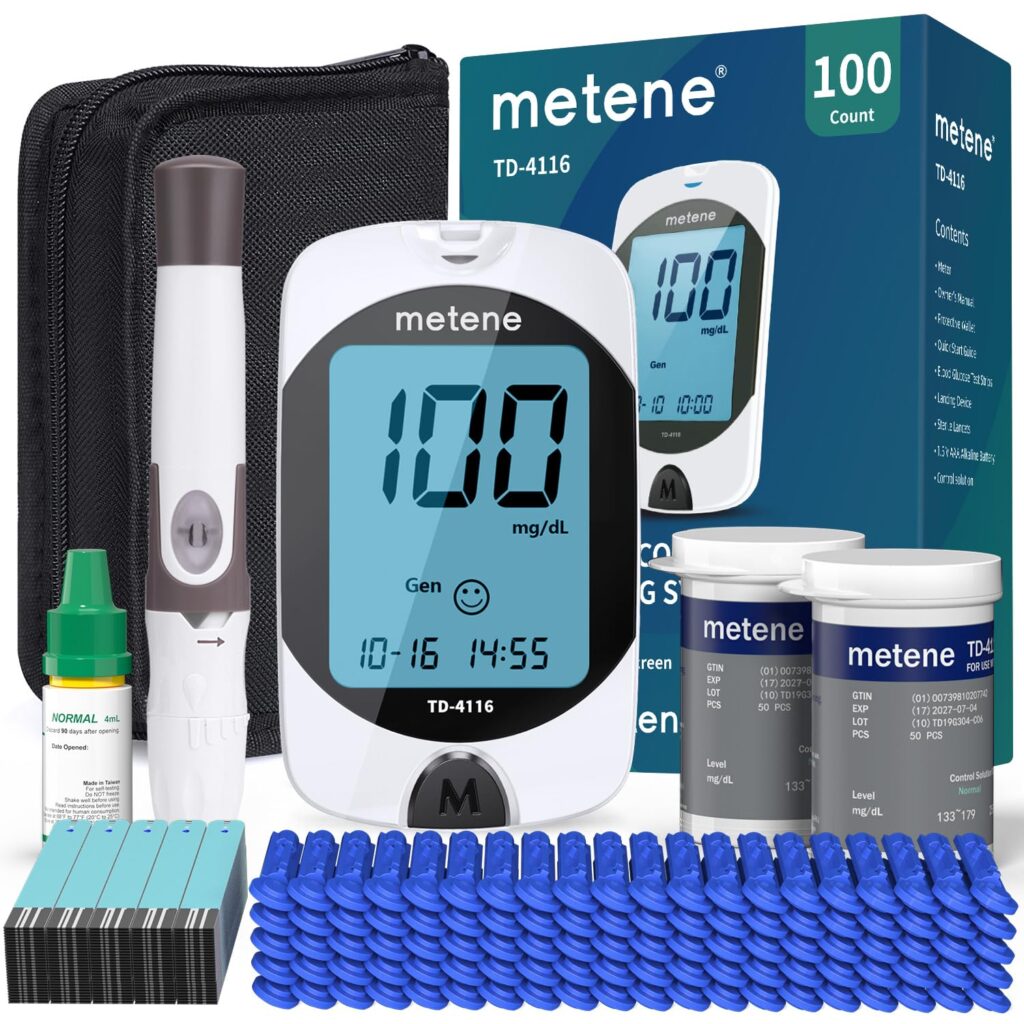
This kit is a reliable pick if you want simple diabetes monitoring at home.
Pros
- No coding needed—just insert a strip and test.
- Large, clear display makes results easy to see.
- Comes with plenty of strips and lancets.
Cons
- Can’t sync results to a phone app.
- Sometimes shows ? values and needs a retest.
- Lancing device feels a bit basic.
Using the Metene TD-4116 kit felt pretty straightforward. Setting it up took just a couple of minutes, and we liked not having to mess with coding before each test.
The included guide was easy to follow, so we didn’t get lost. Each test took about seven seconds—nice and quick.
We needed only a tiny blood sample, so our fingers didn’t get too sore. The display’s bright, and the numbers are big enough for anyone who struggles with small text.
Reminder alarms are built in, nudging us to test throughout the day. No Bluetooth or app connection here, and sometimes we had to retest if a reading looked weird.
Still, with lots of strips and a simple process, this feels like a solid choice for daily diabetes care.
Glucoracy G-425-2 Diabetes Test Kit
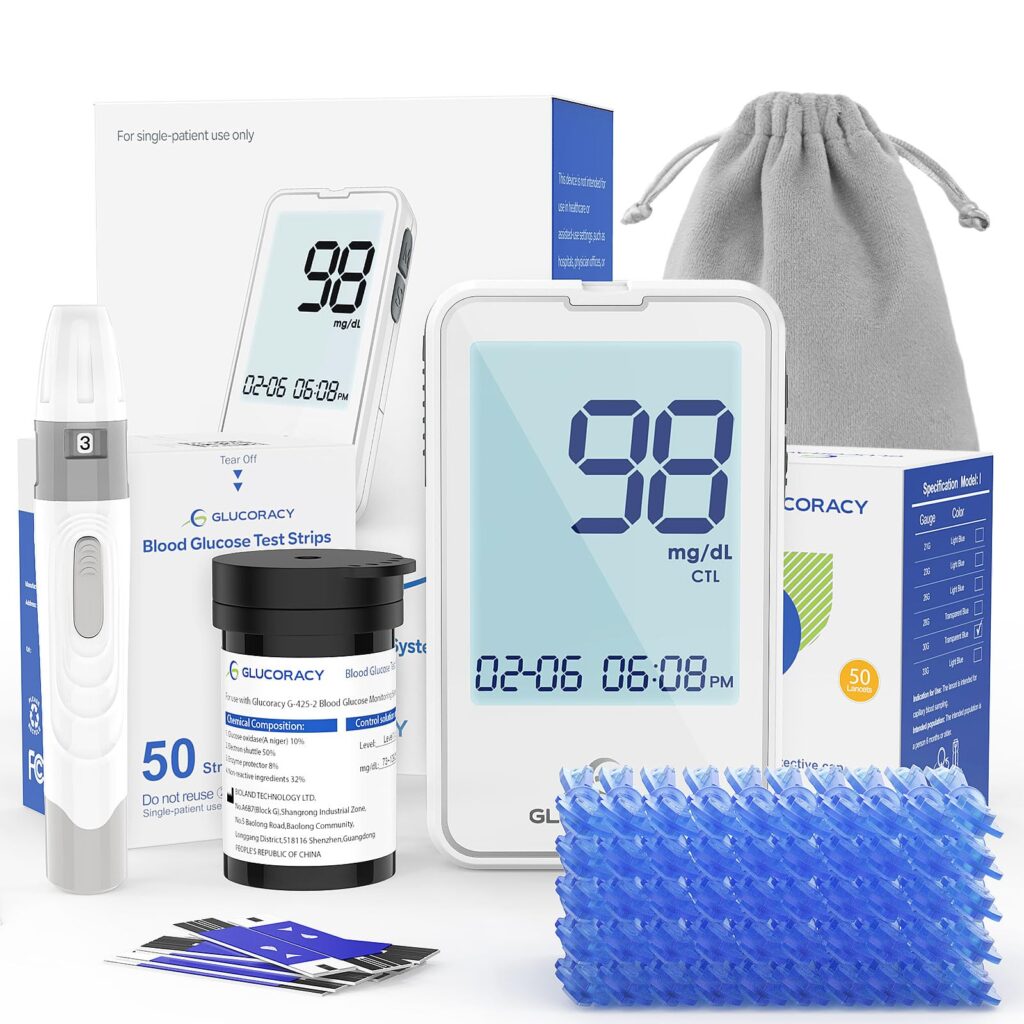
This is a good pick if you want a simple, all-in-one blood glucose testing kit that’s easy to use at home.
Pros
- Results show up in about 6 seconds.
- Needs just a tiny drop of blood.
- Comes with everything you need to start testing.
Cons
- First-timers might need to watch a tutorial.
- Memory holds less than some pricier monitors.
- Design is pretty basic—not everyone’s favorite.
After trying the Glucoracy G-425-2 kit, we found setup quick and the instructions clear. The no-coding feature meant we could get started almost right away.
All the parts fit neatly in the included case, which actually helped us keep things organized. The kit asks for just a tiny blood sample, and the test is less painful than we expected.
Readings pop up fast, and the device stores almost 450 results. We didn’t have to write anything down.
There’s a bit of a learning curve, though. Watching video guides before starting really helps, especially if you’re new to this.
The memory is big enough for most people, but if you test a lot, it might not be enough. For the price and the features, this kit does what it promises without adding extra hassle.
Contour Next Test Strips, 70 Count
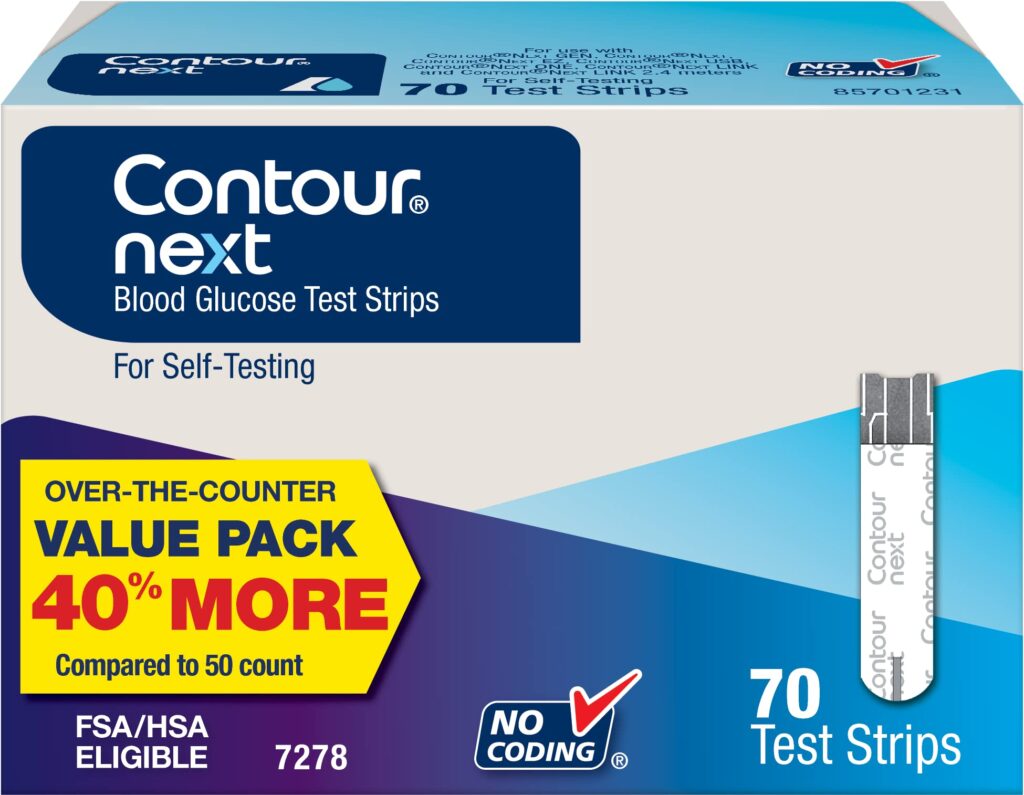
These test strips are a good fit for reliable and easy blood glucose testing at home, especially if you already use a Contour Next meter.
Pros
- Very accurate readings from a small blood sample.
- Second-chance sampling helps avoid wasting strips.
- No coding step—just test and go.
Cons
- Works only with Contour Next meters.
- Can cost more than generic strips.
- Bottles can be tricky to open for some folks.
We noticed how much easier testing became with these Contour Next strips. No coding means fewer steps, which we always appreciate.
The second-chance feature really stood out. If we didn’t get enough blood on the first try, we could add more to the same strip instead of tossing it.
Results felt consistent and matched up with what we got at the doctor’s office. These strips only fit Contour Next meters, though, so keep that in mind if you have a different brand.
Ascensia CONTOUR NEXT ONE Glucose Kit
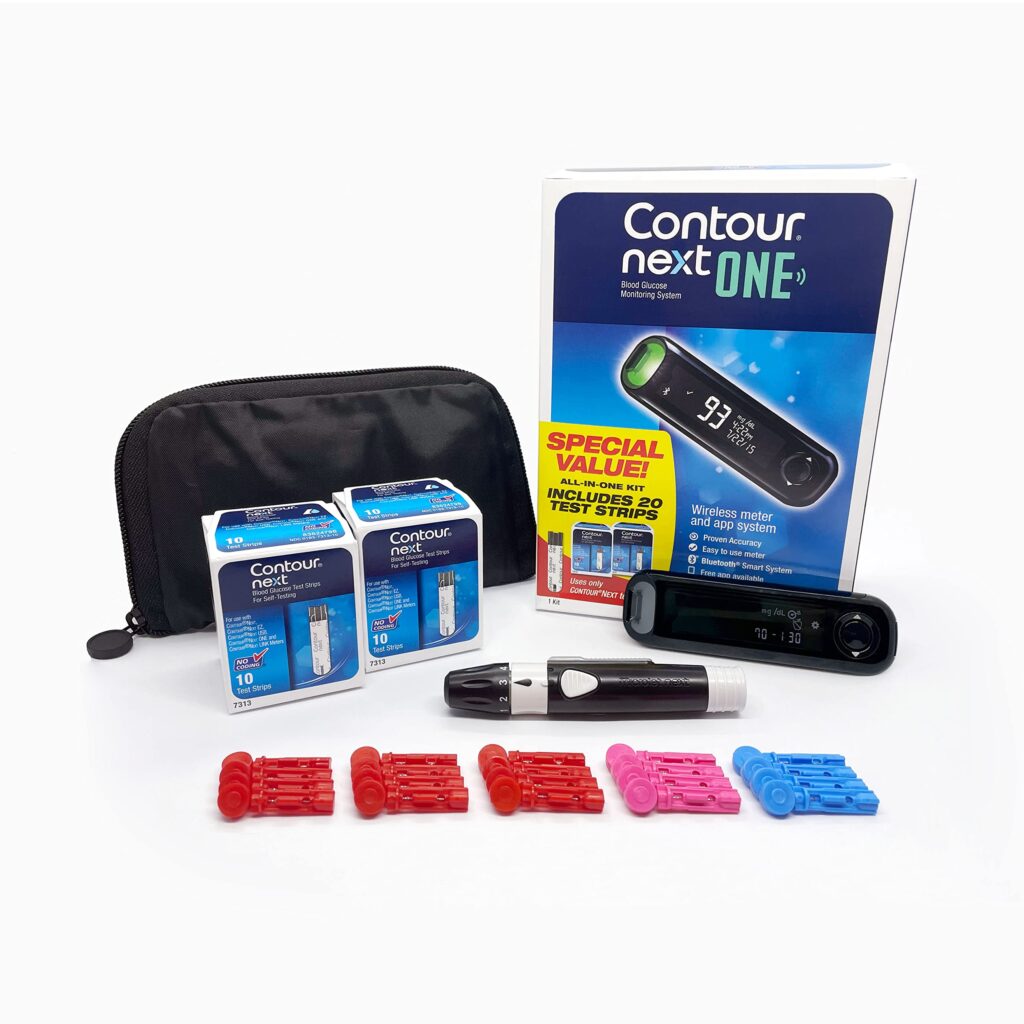
If you want reliable, easy blood sugar testing that syncs with your phone, this is a strong option.
Pros
- Syncs to a smartphone app via Bluetooth.
- Super small and portable—fits in a pocket or small bag.
- Second-chance feature cuts down on wasted strips.
Cons
- Test strips run out fast and can get pricey.
- App setup and Bluetooth pairing can be confusing.
- Kit comes with a limited number of lancets.
We set up the CONTOUR NEXT ONE pretty quickly, and the small carrying case kept everything together. The kit feels compact—not bulky at all.
We liked how fast it gave us results, and the colored light immediately showed if we were in range. That’s a nice touch.
Syncing with the smartphone app worked through Bluetooth. The app saves our results, so we can spot patterns over time.
It also connects with Apple Health, which puts all our data in one place. The only real downside is the kit includes just 20 strips and 10 lancets, so you’ll need refills soon.
The second-chance feature helps save strips if you don’t get enough blood the first time. For easy tracking and reliable readings in a tiny kit, this one’s pretty practical.
Glucoracy Blood Sugar Test Kit
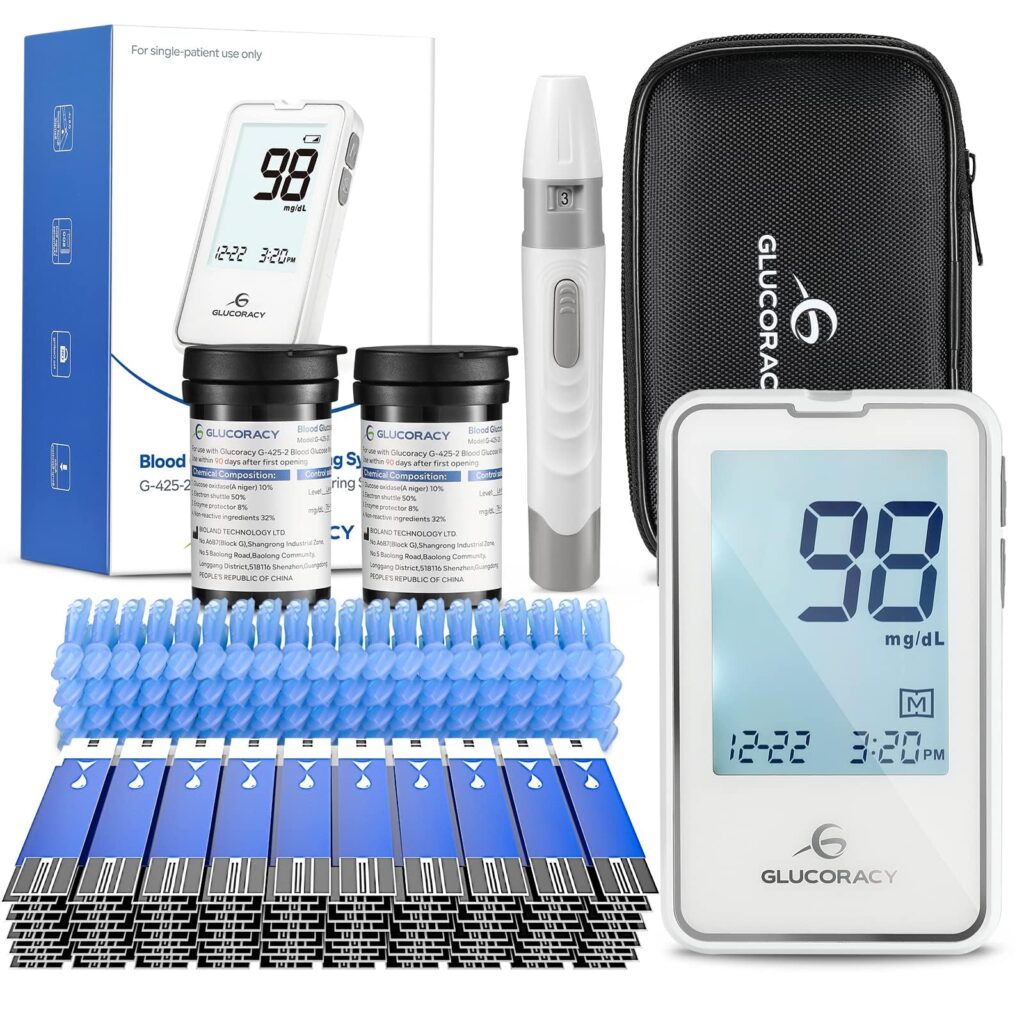
This kit works well if you want a complete, easy-to-use blood glucose testing system right out of the box.
Pros
- Comes with lots of test strips and lancets.
- Simple to set up and use.
- Large, clear display makes results easy to read.
Cons
- Only works with Glucoracy test strips.
- Saving and reviewing results can be confusing.
- Accuracy may vary a bit for some users.
We found the setup process for the Glucoracy Blood Sugar Test Kit very simple. The storage case kept everything organized, which made traveling or storing it at home easier.
With 100 test strips and lancets included, we didn’t worry about running out quickly. Testing was fast—results appeared on a large, easy-to-read screen in just a few seconds.
The lancing device offers different depth settings, which is nice for different skin types. The monitor can save a lot of results, so tracking glucose over time is possible.
This kit only works with Glucoracy’s own test strips, so we couldn’t use any extras from other brands. Navigating the memory function took a little figuring out, and a few of us noticed small differences between this meter and others.
Still, it’s convenient, well-priced, and covers the basics for home use.
Buying Guide
When we pick out a diabetes test kit, there are a few features we just can’t ignore. Top of the list? Accuracy, the method of testing, and of course, ease of use.
Accuracy really matters. The kit should give us the right results every time, no excuses.
Let’s talk about the main things to compare:
| Feature | What To Check |
|---|---|
| Accuracy | Standards met; user reviews |
| Ease of Use | Simple instructions; clear display |
| Sample Type | Blood, urine, or non-invasive |
| Cost | Upfront price and ongoing expenses |
| Data Tracking | Memory storage; mobile app compatibility |
| Speed | Time needed for results |
| Test Strips | Availability and price |
| Support | Customer service; clear instructions |
Ease of Use: Clear instructions and easy-to-read displays make a real difference. Some kits only need a tiny blood sample, which is a relief.
Data Tracking: Some kits store old results or connect with phone apps. That’s pretty handy for keeping tabs on your readings over time.
Cost: Look at both the price of the kit and how much the test strips will run you. Some strips cost more than others, especially the specialty ones.
Support: Good customer service and simple instructions can really help, especially if you’re just starting out with home testing.
We all weigh these features a bit differently, right? Think about what matters most in your daily routine and pick the kit that fits you best.
Frequently Asked Questions
We trust diabetes test kits to help us track our blood sugar. Knowing how they work and where to get them makes a difference.
How do non-invasive blood glucose monitors work?
Non-invasive monitors check blood sugar without any finger-pricking. They use sensors—usually light or electrical currents—to scan the skin or tissues.
They’re pretty comfortable. Some even use armbands or wristbands to check glucose levels through the skin, which sounds almost futuristic.
What should I look for when choosing a blood sugar test kit?
Look for accuracy, ease of use, and how quickly you get results. Some kits use just a drop of blood, while others have big, easy-to-read screens or memory for past readings.
Make sure the test strips are affordable and easy to find. Good support and simple instructions never hurt.
Where can I obtain a free diabetes test kit?
Some health clinics, hospitals, and community centers hand out free kits. Diabetes organizations sometimes run programs too.
Depending on your insurance or prescription coverage, you might get a kit covered. It’s worth asking your doctor or insurance provider about it.
What is considered a normal range for blood sugar using a test kit?
For fasting blood sugar, the usual range is between 70 and 99 mg/dL. After eating, it can go up to around 140 mg/dL.
These numbers might shift depending on your age, health, or what your doctor recommends. Honestly, your doctor’s advice always wins here.
Are blood sugar test kits available at major retailers?
You can find these kits at Walmart, CVS, Walgreens, and Target. Most pharmacies have them in stock too.
Online shops like Amazon offer a ton of options as well, if you prefer shopping from your couch.
How do blood glucose meters differ from continuous glucose monitors?
Blood glucose meters show a single reading when you use a test strip and a drop of blood. You have to test several times a day, which can get a bit tedious.
Continuous glucose monitors (CGMs) use a small sensor you wear on your skin. They check your blood sugar all day and night, giving you tons of readings—no finger pricks needed.
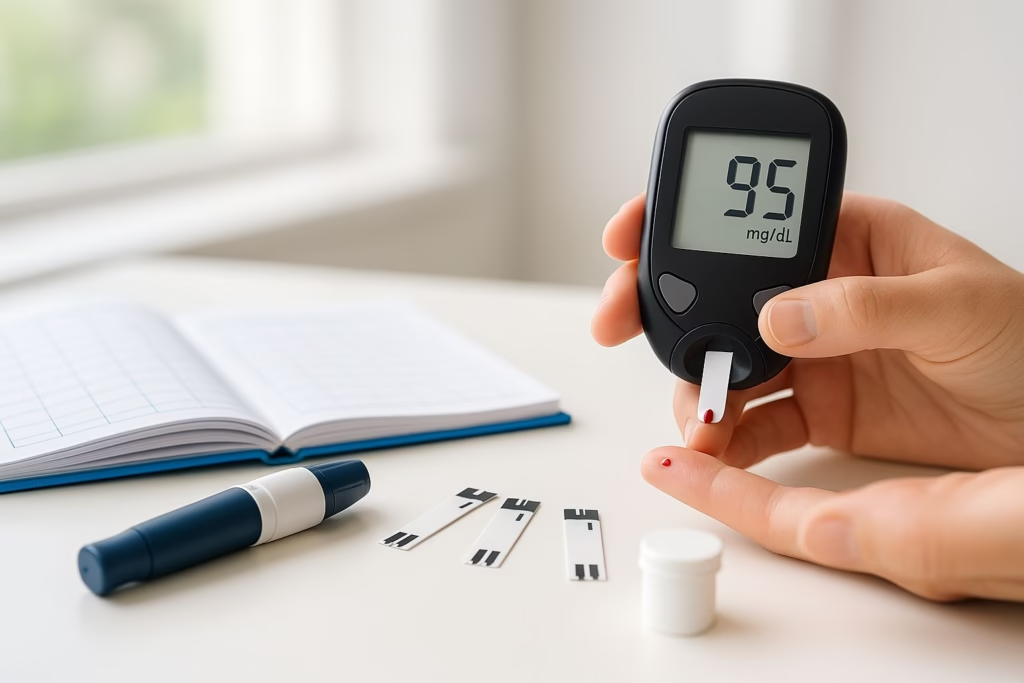



Pingback: Diabetes 2 Blood Glucose Levels: Ranges, Monitoring & Control - Pharma Heals